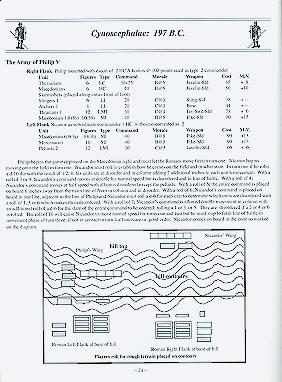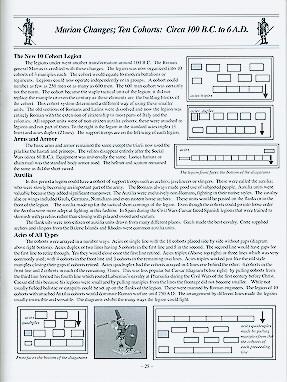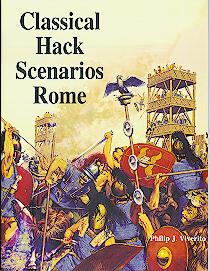| Brief Description |
The supplement consists of a series of scenarios based on specific battles,
connected by explanations of the changing military organizations. There is also a historical campaign (six linked
battles), plus variant rules. All scenarios are fought on a 4' x 6' game table. The scenarios
can be scaled down (or up), for those who wish to use fewer (or more) figures.
The nine independent scenarios are:
- Rome Fights Fidenae (725 B.C.)
- The men of Fidenae raided up to the gates of Rome, and now Romulus and his Romans are
outside the gates of Fidenae. Using feigned flight to draw the Fidenae out from their
town, Romulus seeks to maneuver his enemies into his waiting ambush. In addition to map
and army lists, background and a comprehensive army list are given for Rome. 3 pages.
Figure scale: 1/50
Figures: 70 (Rome) vs. 64 (Fidenae)
- The Allia Valley (390 B.C.)
- Brennus and the Gauls advance into Italy, expecting to plunder the Romans as they have
the Etruscans in the past. Two Roman legions stand to block them at the Allia, a small
stream that flows into the Tiber. Background describes the army changes made by Servius
Tullius, with two historical interpretations of how the Roman phalanx-based army might have been organized. 5 pages.
Figures: 216 (Rome) vs. 295 (Gauls)
- Heraclea (280 B.C.)
- Pyrrhus of Epirus meets the Romans at a crossing on the Siris river. Background explains the transition from a phalanx-based army to the new legions,
and gives one historical interpretation of how a "5 line" legion might have been organized. 4 pages.
Figure scale: 1/50
Figures: 329 (Rome) vs. 232 (Pyrrhus)
- Asculum Second Day (279 B.C.)
- The Roman Consuls Decius and Sulpicius checked Pyrrhus' advance on the first day of
fighting at Asculum. This scenario is about the second day's fighting, as the Romans risk a
river crossing to come to grips with their opponent. 2 pages.
Figure scale: 1/50
Figures: 285 (Rome) vs. 203 (Pyrrhus)
- Regulus in Africa (255 B.C.)
- At the Battle of Tunes, Roman Consul Regulus makes a landing against Carthage, and
comes up against Xanthipuss. Background explains the organization of a "3 line" legion
and the role of Latin allies. (At the players' option, a 5-line legion could be substituted for
this battle.) 3 pages.
Figures: 205 (Rome) vs. 197 (Carthage)
- The Battle of Ilipa, Southern Spain (206 B.C.)
- Scipio Africanus battles Hasdrubal (brother of Hannibal) for control of Spain. 2 pages.
Figure scale: 1/100
Figures: 418 (Rome) vs. 540 (Carthage)
 
- Cynoscephalae (197 B.C.)
- Rome had invaded Greece. Flaminius seeks to crush the potential threat of Philip V of
Macedonia. A skirmish over a ridgeline develops into a full battle. 2 pages.
Figures: 212 (Rome) vs. 140 (Macedonia)
- Caesar and Pharnaces, Zela (47 B.C.)
- After the Egyptian campaign, Caesar goes East to fight for control of the Kingdum of Pontus.
At Zela, Caesar takes the defensive on a ridgeline with understrength forces. Background
material explains the Marian changes and the new 10-cohort legion. 4 pages.
Figures: 174 (Rome) vs. 194 (Pontus)
- Mons Graupius (83 A.D.)
- Agricola vs. the Caledonians in what is now modern Scotland. Background explains the
military changes made by Augustus. 3 pages.
Figures: 270 (Rome) vs. 255 (Caledonia)
A Campaign in Spain, 76 B.C. to 75 B.C., is a series of six battles involving
Pompey the Great versus the rebellious Spanish governor Sertorius. The first two battles
are stand-alone scenarios, while the following four scenarios can be linked by having losses
in a previous scenario apply to the following one.
- Pompey vs Sertorius (76 B.C.)
- While Pompey fights the rebels, more rebels appear behind his main line. 2 pages.
Figures: 272 (Rome) vs. 174 (Rebels)
- Metellus & Hertulius (76 B.C.)
- Rebels march directly into battle, despite fatigue and thirst. 1 page.
Figures: 160 (Rome) vs. 288 (Rebels)
- Pompey & Heannius (75 B.C.)
- Almost a three-sided battle, as both Heannius and Peperna (rebel generals) compete to destroy
Pompey. 2 pages
Figures: 204 (Rome) vs. 182 (Heannius) and 116 (Peperna)
- Metellus & Hertulius (75 B.C.)
- 2 pages.
Figures: 280 (Rome) vs. 352 (Rebels)
- Pompey & Sertorius (75 B.C.)
- Romans are thirsty and fatigued at start of battle. 2 pages.
Figures: 152 (Rome) vs. 162 (Rebels)
- Pompey & Metellus vs Sertonius & Peperna (75 B.C.)
- 2 pages.
Figures: 220 (Rome) vs. 324 (Rebels)
Also included in this supplement:
- Beginner's Army Lists for the Second Punic War
- "Starter" 100-point armies, composed of roughly 10 units and 100 figures - Roman,
Carthaginian, Gallic, Spanish, Numidian. There is also an army list for the Latins as
an optional ally. Made for use with the variant rules. 4 pages.
- Forsythe's Classical Hack Variants for the Second Punic War
- Essentially, a streamlined version of the game which "is equal to the original system."
Includes modified sequence of play, condensed movement chart, "smoother way" to handle
fire. With new Casualty Chart and reference table. 6 pages.
|
|---|

